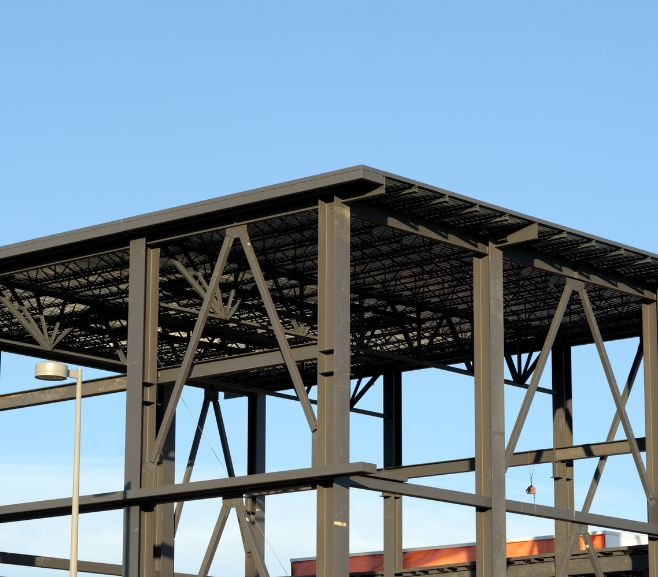Steel building kits have gained immense popularity in recent years due to their durability, strength, and cost-effectiveness. They are an ideal choice for building structures such as garages, warehouses, workshops, and even homes. However, not all steel building kits are created equal, and it is important to understand the different types of materials available to make an informed decision. In this article, we will explain the various steel building kit materials, their characteristics, advantages, factors to consider when choosing, and maintenance tips.
Types of Steel Building Kit Materials
Galvanized Steel
Galvanized steel is coated with a layer of zinc to prevent rust and corrosion. It is commonly used in steel building kits due to its affordability and high resistance to wear and tear. Galvanized steel is available in different grades, depending on the thickness and durability required.
Galvalume Steel
Galvalume steel is similar to galvanized steel but has a mixture of zinc, aluminum, and silicon coating. It is highly resistant to corrosion, making it an ideal choice for buildings located in areas with high humidity and rainfall. Galvalume steel is also energy efficient, reflecting sunlight to reduce heat absorption.
Stainless Steel
Stainless steel is a popular choice for steel building kits due to its strength, durability, and low maintenance requirements. It is resistant to corrosion, staining, and rust, making it ideal for structures exposed to moisture and harsh weather conditions. Stainless steel is available in various grades, depending on the level of corrosion resistance required.
Carbon Steel
Carbon steel is a strong and durable material that is commonly used in steel building kits. It is highly versatile and can be easily customized to suit different building requirements. Carbon steel is available in different grades, depending on the level of hardness and strength required.
Characteristics of Steel Building Kit Materials
Steel buildings kit materials offer several characteristics that make them ideal for building structures of all kinds.
Durability
Steel building kit materials are highly durable and can withstand extreme weather conditions, such as high winds, heavy rain, and snowfall. They are also resistant to pests, fire, and other environmental factors that can cause damage to conventional building materials.
Strength
Steel building kit materials are incredibly strong and can support heavy loads without bending or breaking. They are an ideal choice for structures that require a high load-bearing capacity, such as warehouses, storage facilities, and workshops.
Corrosion Resistance
Steel building kit materials are resistant to rust and corrosion, making them ideal for structures located in areas with high humidity and rainfall. Galvalume steel, on the other hand, is a type of steel that is coated with a mixture of aluminum and zinc, making it even more resistant to corrosion than galvanized steel. It is often used in coastal areas or areas with highly corrosive environments.
Fire Resistance
Steel building kit materials are highly fire-resistant, making them an ideal choice for structures that need to comply with strict fire codes. They are also less likely to ignite in case of a fire, reducing the risk of spreading flames.
Low Maintenance
Steel building kit materials require minimal maintenance, making them a cost-effective choice in the long run. They do not require painting or sealing, and regular cleaning is enough to keep them in good condition.
Energy Efficiency
Steel building kit materials are highly energy-efficient, reducing heating and cooling costs in the long run. They have a high R-value, which means they can keep the interior temperature consistent, regardless of the outside temperature.
Advantages of Steel Building Kit Materials
There are several advantages to choosing steel building kit materials over conventional building materials.
Cost-effective
Steel building kit materials are highly cost-effective compared to traditional building materials. They are also easy to install, reducing labor costs and saving time.
Easy and Quick Installation
Steel building kits can be easily assembled, reducing installation time and labor costs. They come with pre-drilled holes and detailed instructions, making them an ideal choice for DIY enthusiasts.
Customizable Design
Steel building kits offer a wide range of design options, from traditional to modern styles. They can be customized to fit any building requirement, including size, shape, and layout.
Environmentally Friendly
Steel building kit materials are environmentally friendly, as they are recyclable and can be repurposed at the end of their lifespan. They also require less energy to produce than traditional building materials.
Factors to Consider When Choosing Steel Building Kit Materials
When choosing steel building kit materials, there are several factors to consider.
Building Purpose
The purpose of the building will determine the type of steel building kit materials required. For example, a garage will require different materials than a warehouse or a workshop.
Climate Conditions
The climate conditions in the area will determine the type of steel building kit materials required. For example, buildings located in areas with high humidity and rainfall will require materials that are highly resistant to corrosion.
Budget
The budget will determine the type and grade of steel building kit materials required. Higher-grade materials may cost more upfront, but they will offer better durability and longevity in the long run.
Maintenance
The maintenance requirements of the steel building kit materials should be taken into account when choosing them. Materials that require less maintenance will be more cost-effective in the long run.
Aesthetic Appeal
The aesthetic appeal of the steel building kit materials should also be taken into account when choosing them. Different materials offer different design options, and the chosen material should match the style of the building.
Maintenance Tips for Steel Building Kit Materials
Maintaining steel building kit materials is simple and straightforward, and it involves regular cleaning and rust prevention.
Cleaning
Steel building kit materials should be cleaned regularly to prevent the buildup of dirt and debris. A pressure washer or a soft-bristled brush can be used to clean the surfaces, and a mild detergent can be used to remove stubborn stains.
Rust Prevention
Steel building kit materials should be inspected regularly for signs of rust, and rusted areas should be treated immediately to prevent further damage. A rust converter or a rust inhibitor can be used to remove rust and prevent its recurrence.
Conclusion
Steel building kit materials offer several advantages over traditional building materials, including durability, strength, and cost-effectiveness. Choosing the right material for a building project is crucial, as it will determine the longevity, durability, and maintenance requirements of the structure. Steel building kit materials are an ideal choice for anyone looking to build a durable and long-lasting structure that requires minimal maintenance.




